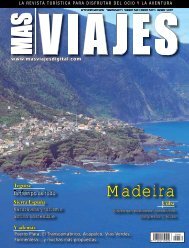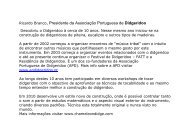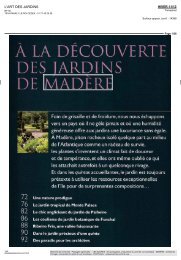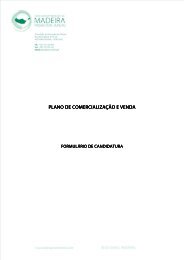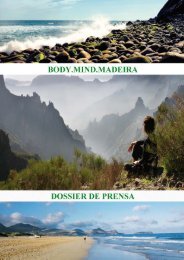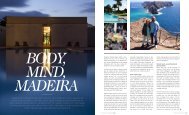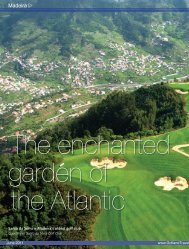Madeira Press Kit - Associação de Promoção da Madeira
Madeira Press Kit - Associação de Promoção da Madeira
Madeira Press Kit - Associação de Promoção da Madeira
Create successful ePaper yourself
Turn your PDF publications into a flip-book with our unique Google optimized e-Paper software.
BIRDWATCHING BIRDWATCHING BIRDWATCHING IN IN IN MADEIRA MADEIRA<br />
MADEIRA<br />
Bird Watching is an activity which has more than 80 million a<strong>de</strong>pts over the world. In the<br />
last years, this activity has <strong>de</strong>veloped greatly in <strong>Ma<strong>de</strong>ira</strong>, due to the excellent conditions<br />
for its practice.<br />
In <strong>Ma<strong>de</strong>ira</strong> archipelago there are 42 breeding species and three of them are en<strong>de</strong>mic to<br />
<strong>Ma<strong>de</strong>ira</strong> Island: the Zino’s Zino’s Pe Petrel Pe<br />
trel trel (Petrodroma ma<strong>de</strong>ira) the most threatened seabird of<br />
Europe that only breeds on the highest mountains of <strong>Ma<strong>de</strong>ira</strong>; the <strong>Ma<strong>de</strong>ira</strong> <strong>Ma<strong>de</strong>ira</strong> Laurel Laurel Pigeon<br />
Pigeon<br />
(Columba trocaz) that is strongly associated with Laurel Forest where it feeds from the<br />
Laurel berries; and the <strong>Ma<strong>de</strong>ira</strong> Firecrest (Regulus ignicapillus ma<strong>de</strong>irensis) the smallest<br />
bird that occurs on the archipelago. Besi<strong>de</strong>s these species there are also four birds that<br />
only exists on Macaronesia (bio geographic region which inclu<strong>de</strong>s <strong>Ma<strong>de</strong>ira</strong>, Azores, Canary<br />
and Cape Ver<strong>de</strong> archipelagos): the Feae’s Petrel (Pterodroma feae) seabird that only<br />
breeds on Desertas Islands, in Bugio, and Cape Ver<strong>de</strong>; the Canary Canary (Serinus canaria) one of<br />
the most common birds on <strong>Ma<strong>de</strong>ira</strong> that also exists on Azores and Canaries; the<br />
Berthelot’s Berthelot’s Berthelot’s Pip Pipit Pip it (Anthus berthelotii) and the Plain Plain Swift Swift (Apus unicolor) both only occur<br />
in the archipelagos of <strong>Ma<strong>de</strong>ira</strong> and Canaries.<br />
But the total number of birds that could be observed here is much higher, probably<br />
around 220 species.<br />
The numbers of European birdwatchers that visit the <strong>Ma<strong>de</strong>ira</strong> archipelago have increased<br />
in recent years and one of the reasons is the excellent opportunity for watching seabirds<br />
from the mainland or boat crossings between the nearby islands. In <strong>Ma<strong>de</strong>ira</strong> it is possible<br />
to find several seabirds that are not use to be found in other European regions such as<br />
Cory’s Shearwater (Calonectris diome<strong>de</strong>a), Little Shearwater (Puffinus assimilis) and<br />
<strong>Ma<strong>de</strong>ira</strong> Storm Petrel (Oceanodroma castro). <strong>Ma<strong>de</strong>ira</strong> Archipelago offers excellent<br />
conditions to birdwatchers, not only in terms of breeding birds but also vagrants. Here is<br />
our breeding species and subspecies:<br />
<strong>Ma<strong>de</strong>ira</strong> <strong>Ma<strong>de</strong>ira</strong> En<strong>de</strong>mic En<strong>de</strong>mic SSpecies<br />
S<br />
pecies<br />
Zino's Petrel (Pterodroma ma<strong>de</strong>ira)<br />
Trocaz Pigeon (Columba trocaz)




